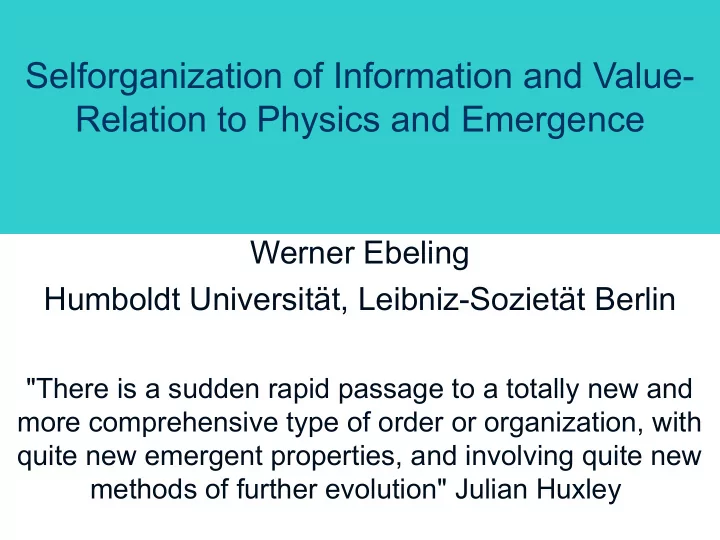

Selforganization of Information and Value- Relation to Physics and Emergence Werner Ebeling Humboldt Universität, Leibniz-Sozietät Berlin "There is a sudden rapid passage to a totally new and more comprehensive type of order or organization, with quite new emergent properties, and involving quite new methods of further evolution" Julian Huxley
Emergence is our main topic: What means emergence? • Wikipedia: .. whereby larger entities, patterns, and regularities arise through interactions among smaller entities that do not exhibit such properties . Emergence is central for complex systems. For instance, the phenomenon life, E. can be explained but not deduced. For a long time physicists did not support this view, but now they support it influenced e.g. by Boltzmann, Anderson, Prigogine, Huxley and Simon .
The new holism in physics and the idea of selforganization The concepts of selforganization, synergetics and nonlinear processes led to a new physics of complexity. • If we want to understand a wood we have to go beyond the study of leafs. Having problems with our car, do not contact physicists, but a mechanic. • The key concept from the side of physics, the first emergent concept is ENTROPY
ENTROPY • measure of • Of disorder and complexity, • Of value of energy, • Of amount of Information • • • Entropy is like head of Janus!
Entropy and second law
Entropy STATPHYS Complexity Ludwig Boltzmann Josiah W. Gibbs
Climate, ecosystems, society are among the most complex systems: low predictabilty
The new holism is based on emergence and
From Being to Becoming
Open systems: energy transf. and entropy-Export • Import of high-valued Input Output energy and export of low value energy = conditio sine qua non. Energy E-transformat. Low.E • In other terms : SYSTEM Entropy Export, compensating production of entropy Entropy S-production. Entropy
SO, nonlinearity, complexity CHAOS are connected complex dynamics is difficult to predict - time horizon
SO on Earth is driven by Photon mill sun - earth
First: SO + Info processing of proteins and polynukleotides • Theory of Manfred Eigen (1971), SO of complex macromolecules, • Replication competition, selection • Evolution of genetic language • biolog. Information processing, • Life = SO of Info processing systems (Definition of life?) Information is an emergent property and connected with valuation.
Origin of information (see R.Feistels and K. Fuchs-K. talk) Information-processing systems exist only in the context of life and its descendants: animal behaviour, human sociology, science, technology etc. Information processing we consider as a special high form of self- organization.
Relation physics information: Can it be reduced to physical terms like entropy? NO' entropy measures only quantity. Many interesting discussions (see e.g. the FIS- dicussion ), but no general agreement. Our view “information” and the related concept “values” are not physical terms. However transfer of information and value is always related to transfer of a universal physical quantity, the entropy. In this way, information is subject to physics but it cannot be reduced to physics alone.
Life and information (see Rainer Feistels talk) Information processing and valuation are the central aspects of life. We define a living system as a natural, ordered and information-processing macroscopic system with an evolutionary history. This may be even used as a criterion for decisions of the staff on a space–ship which meet far from our home-planet earth unknown objects moving in space, sending signals and doing maneuvers, should they meet it with the respect for living objects? Information processing we consider as a special high form of self-organization. Information is an emergent property. Symbolic information is always related to an ultimate purpose and this is connected with valuation.
About values as central concept: Values are also related to physics: Wilhelm Ostwald considered entropy as a measure of the value of energy. In the social sciences the concept of values Economy:Adam Smith in the 18 th century, worked out later by Ricardo, Marx, Schumpeter etc.. In social context the idea was used by Malthus . In biology Darwin and Wallace . Sewell Wrigh t developed the idea of a fitness landscape (value landscape) which was subsequently worked out by many authors; new results on the structure of landscapes were obtained by Peter Schuster in Vienna. D ynamical model: Fisher-Eigen equation
About value of information and relation to society: Value of info is given by the system in which the receiver is imbedded and by the possibilities to make a choice between several actions in relation to an imbedding ensemble = in nature / society
Examples of value of info in context of nature 1. Exists a direct/linear relation T-CO _2 ? NO 2. Are catastrophes as volcanoes, hurricans predictable? NO
Examples of value of info in context of society 1. Can we predict financial crashes ? 2. Can we predict of human consumption/global/ spying/Goo 3. Predictability of political actions / the big brother/ NSA etc.
Collective character of information and values Info is at least binary, value is an ensemble property . Formation of information and values is a collective phenomenon and is due to selforganization. By c o-operative interactions, states with new, emergent properties transcending the properties of their constitutive parts." Also the value of a species which means the fitness (see Darwin). Competition is based on some kind of valuation. .
Conclusions Information and values are emergent concepts. They are abstract non-physical properties in dynamical system context. Values express the essence of biological, ecological, economic or social properties and relations with respect to the dynamics of the system. The valuation process is an essential element of all information processes in nature and society and related to competition.
Recommend
More recommend